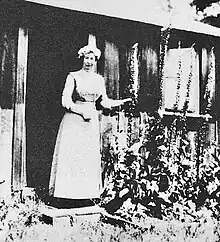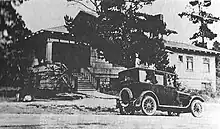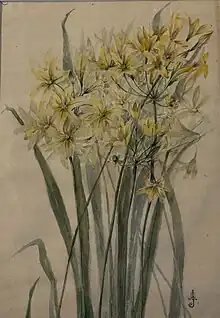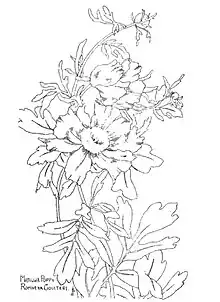Ida A. Johnson
Ida A. Johnson (January 1850 – March 7, 1931), also known as I. A. Johnson, was an American botanical still life and china painter and an enduring partner of the artist Josephine M. Culbertson. She played a role in establishing the Carmel Art Association located in Carmel-by-the-Sea, California. Johnson’s dedication to the arts extended to her involvement in various clubs and associations, such as the Carmel Boys' Club and the Dicken's Club, where she fostered artistic growth and camaraderie among fellow artists. She was instrumental in founding Carmel's first free library, which developed into the Harrison Memorial Library.[1]
Ida A. Johnson | |
|---|---|
 Ida Johnson (1850-1931) | |
| Born | Ida Anna Johnson January 4, 1850 Nyack, New York, US |
| Died | March 7, 1931 (aged 81) |
| Occupation | Watercolorist |
| Partner | Josephine M. Culbertson |
Early life
Johnson was born in January 1850 to a Quakers family in Nyack, New York. Her father was Egbert Benton Johnson (1821–1906). Her mother was Cordelia Haight (1821-1908).[2][3]
Johnson received artistic training at the Parker School in Brooklyn. She was one of Josephine M. Culbertson's classmates at Parker School and resided at Culbertson mother's residence.[4] She attended painting, printmaking, and photography classes at Arthur Wesley Dow's Summer School of Art in Ipswich, Massachusetts. Her work as a ceramist and still life painter quickly garnered recognition, earning her acclaim in artistic circles.[5][6]
Career
Both Johnson and Culbertson made early decisions to pursue artistic careers and became friends and companions. Johnson became an instructor in ceramics at Adelphi College in New York for almost ten years. For a span of four years, she held the position of president within the National Ceramic Society.[7][6]
They exhibited with the Brooklyn Art Association garnering recognition within the artistic community. Johnson supported herself largely by painting florals on china, known as china painting, earning her a national reputation in that field. In addition to her pursuits in botanical still life and porcelain art, she also showcased her artistic talent in painting watercolors of botanically accurate flowers.[1]
After establishing a studio and salon in Brooklyn, at 193 St. James Place, the two women joined forces to collaborate on a show in New York City. Johnson painted a single bloom, while Culbertson depicted the same flower in its natural surroundings, showcasing their distinct artistic styles.[4] In 1901, they hosted their annual art reception at their studio, showcasing a collection of their watercolor sketches to visitors and art enthusiasts.[8]
In addition to her artistic pursuits, Johnson held the position of the second vice president at the Cambridge Club, showcasing her involvement in community engagement. She played a prominent role in church work in Brooklyn, serving as an assistant superintendent for many years at a mission Sunday school. She held the position of president within the National League of Mineral Painters.[6]
One of her notable activities included organizing and leading a boys' club, which was organized before the Boys Scouts, demonstrating her dedication to the betterment of the community.[4]
Grey Gables



In 1906, Johnson and Culbertson arrived in Carmel-by-the-Sea, California shortly after the 1906 San Francisco earthquake. Initially, they lived in a home located on Monte Verde Street and 9th Avenue.[6] They then decided to set up an art studio and purchased seven lots, at the southeast corner of Lincoln Street and 7th Avenue, from Carmel developer Frank Davendorf.[4]
In 1915, they commissioned master builder M. J. Murphy to construct their new home, a dwelling that featured two studios. Johnson’s studio was designed for ceramic work, with a window overlooking the garden. Culbertson’s painting studio was situated in the opposite wing of the house.[4][1] They affectionately named their residence "Grey Gables," which quickly became a popular gathering place in the community, attracting artists and young enthusiasts alike.[3][9] Frequent art exhibits were hosted at Grey Gables.[10]
Recorded as a Republican in the Carmel voter index, Johnson also provided evidence in front of the Board of Railroad Commission of the State of California concerning Carmel's water assessment.[6]
In February 1914, The New York Times recognized her as one of Carmel's distinguished artists, praising her dedication to painting wildflowers. Johnson was among the Carmelites who showcased their artworks at the 1915 Panama–Pacific International Exposition in San Francisco, further solidifying her standing in the artistic community.[6]
In March 1917, the general public received an invitation to behold Johnson's newest masterpiece—a captivating "chocolate set, adorned in yellow luster and gold." This creation was showcased during a studio exhibition highlighting her designer porcelain. A mere three months later, her artistic endeavors took center stage once again. Her work became a highlight at a charitable exhibition aimed at supporting the Carmel chapter of the American Red Cross. This event was hosted at the Carmelita Art Gallery, owned by William Silva.[6]
In 1919, Johnson and Culbertson collaborated on exhibitions at New York's Fine Arts Gallery on 57th Street and the Brooklyn Botanic Garden, with support from the Architectural League of New York. Another joint showcase occurred in May 1920 at Stanford University Art Gallery, spotlighting "fifty watercolor studies capturing California's flora." These artworks had recently concluded their display in various galleries across the eastern region. The objective behind these three collaborative exhibitions was to depict "the interplay between flowers and their surroundings," portraying both intricate floral details and their harmonious integration within the environment.[6]
Johnson's attention to native plants once again surfaced at Stanford University in June 1921 for a group show of Carmel Artists curated by Mary DeNeale Morgan. Johnson stood among Carmel's early environmentalists, striving to educate the public about the perils posed by unchecked development. Her well-attended lectures across northern and southern California often centered around the beauty and significance of wildflowers.[6]
Johnson was known for her charitable activities, supporting various organizations and causes in Carmel. She actively contributed to the Dramatic Arts Society, Carmel Community Church, Carmel Boys' Club, Missionary Fund, Dickens Reading Club, and Carmel Reading Circle.[6][3][11]
Johnson and Culbertson took the initiative to establish the Carmel Boys' Club,[3] an organization that boasted notable names such as John and Gordy Campbell, the Taggert Wermuth, Roy Fraties (became police officer), Bob Norton (became Chief of Police), James Hopper Jr. (son of writer James Hopper), Thomas Warren, Kenneth Goold, and Billy Heron (son of Herbert Heron).[6]
A reporter from the Carmel Pine Cone paid a visit to Johnson's studio in May 1927 and provided this assessment of her work, leaving us with valuable insights into her artistic endeavors and passion for capturing the beauty of California's flora.[6]
"Ida Johnson is a flower painter who hesitates at no complexity of nature’s bouquets – she brings off her flowers as conquerors of both light and color and harmony of design. Her paintings of heavy headed flowers are so solid that one feels a desire to poke an explorative finger among their serried blooms. On the studio walls are Fairy Lanterns as delicate and fanciful to behold as the fragile flowers that cling to the fern beds in deep ravines; while on another canvas graceful drooping stems of Bleeding Hearts pour forth a translucence of flaming petals with a sort of negligent ease, and there is before you the marvel of the flower itself in a sheen of crimson color and an elusive web of pattern. Ida Johnson’s flower paintings are not all glow and sparkle; there is solid drawing, good composition and a reserve that stops before too much, as well as that unerring intuition that portrays the peculiar essential of the flower and so richly endows it with this essence. May I say that she has found a most individual expression in exquisite grace."[6]
— Carmel Pine Cone
During the initial weeks of December 1929, her watercolor depictions of wildflowers were exhibited at the Pine Inn for the Carmel Women's Club. This display was curated by Charles Judson.[6]
Despite a severe automobile accident in 1928 in Oakland, California, that left her "bruised and battered." The accident caused serious injuries to her partner, Josephine Culbertson.[12] However, she survived, continuing her painting endeavors.[3]
Carmel Free Library
.jpg.webp)
Following their move to Carmel, Johnson became a founding member of the first Carmel Free Library. In 1906, she took on the position of president of the board and served as librarian in the redwood cabin that housed the library's collection of 500 books. As a tribute to Johnson's significant creative contributions to Carmel, the library later named its computer system "IDA" in her honor.[1][13]
In 1908, Johnson presented a lecture and authored a paper discussing the establishment of the Carmel Free Library Association. Additionally, she undertook the responsibility of head of the library board from 1906 to 1912, playing an active and influential role in the advancement and expansion of the library.[6] On July 16, 1908, she journeyed to Watsonville and gathered at the Christian Church to present a paper on "The Beginnings of a Small Library." During her talk, she outlined the historical development of the small library, emphasizing the importance of promptly cataloging books and records. Furthermore, she provided a comprehensive sketch of the library in its present state, along with its aims and rules. She declared it to be a "free" library, open to all without restrictions on borrowers' applications, merely requiring them to sign a promise to replace any lost books.[14]
In 1928, the Carmel Free library was replaced with the Harrison Memorial Library that was designed by California architect Bernard Maybeck in a Spanish Eclectic style and built by M. J. Murphy, at a cost of $27,373 (equivalent to $343,219 in 2022).[15][9]
Carmel Arts and Crafts Club
From 1909 to 1921, Johnson actively participated as a member and contributor to exhibitions in the Carmel Arts and Crafts Club. Being among the founding members, she also served on the Club's board of directors. In the initial Arts and Crafts exhibitions, Johnson's involvement encompassed painted china. Emerging artists sought instruction at the Club, while the Carmel Reading Circle and the Dickens Club convened their gatherings within its premises.[6][5]
Johnson and Culbertson taught classes in china painting, watercolors, and clay modeling.[16] From 1911 to 1914, Johnson taught china painting and design, a course with 6 lessons, for Summer School Program at the Arts and Crafts Club. The school's instructors included Johnson and Culbertson as well as other instructors like William Merritt Chase, and Mary DeNeale Morgan.[4][9][17][6]
In 1918, Johnson authored the "Club Notes," providing insights into the annual meeting of the Arts and Crafts Club. The notes covered various topics, including a report on the Boys' Club, social gatherings where girls were invited, an adventurous hike to the Pacific Grove Museum, and engaging literary sessions featuring readings from the works of Charles Dickens.[17]
At the Fourteenth Annual Art Exhibition from August 9, to September 4, 1920, Johnson showcased a diverse collection of watercolors, each one titled California Wild Flowers. Continuing her theme, the following year at the same venue, she once again presented a captivating selection of her paintings featuring these beautiful wildflowers.[6][17]
After several years of establishment, the Club established the Arts and Crafts Theater, and Carmel's enthusiasm for play productions grew exponentially, leading the theater contingent to surpass the number of painters. Consequently, many artists felt that the club no longer fully represented their interests. This sentiment prompted the formation of a local art association. Culbertson sent out invitations to various artists, seventy of whom were either local or part-time residents.[4]
During Daisy Brown's visit to Johnson's studio for the Carmel Pine Cone in June 1926, she discovered that the artist had delved into the study of Indian and Mexican flower lore. Johnson had diligently cataloged the botanical and common names of hundreds of plants throughout California, along with the legends surrounding them. A month later, at a joint exhibition with Culbertson, Johnson exhibited fifty watercolor studies of wildflowers with the Arts and Crafts Hall, which were praised for their impeccable resemblance to the flowers in their natural state.[6]
Carmel Art Association
On August 8, 1927, nineteen Carmel artists convened to establish an art association in the living room at Grey Gables.[1] Culbertson chaired the meeting, and local artists, including Mary DeNeale Morgan, participated in the occasion.[4][3][18] Before the meeting concluded, they had established the Carmel Art Association, one of Carmel's significant historical events. The mission statement was "to advance art and cooperation among artists, secure a permanent exhibition space, and foster stronger fellowship between artists and the public."
The first president of the Carmel Art Association was painter Pedro Joseph de Lemos. Culbertson assumed the position of vice president. Clay Otto took charge of securing a suitable gallery in a central area of Carmel for the group's exhibitions and activities.[4][9][19]
The annual meetings of the Carmel Art Association continued to meet at Gray Gables through the early 1930s until a permeant home was selected. In the fall of 1933, the Carmel Art Association moved to its present location on Dolores Street. At this time the Association purchased Ira Remsen's former studio with a loan from businessman Barnet J. Segal.[20][10][5]
Over the years, Johnson painted more than 100 watercolors capturing the beauty of California native plants, which bloomed abundantly throughout the Carmel area each spring.[13][16]
Death
Johnson passed away at the age of 81, on March 7 of 1931 in Carmel, California. The funeral service took place at Johnson's Grey Gables residence, 7th Avenue and Lincoln Street, with Rev. T. Harold Grimshaw officiating the ceremony. Following the service, her remains were sent to Atascadero, California for cremation. The pallbearers at the funeral were Franklin Murphy, Windsor Josselyn, Haskell Warren, George Joselyn, Scott Douglas, Tom Hooper, and Rob Norton, all former members of the Boy's Club. For nearly six decades, Johnson and Culbertson had shared their lives together.[3][4][7]
Legacy
Jerome and Hope Hasty, Johnson's grandnephew and niece, alongside the staff at Harrison Memorial Library, undertook the restoration of a set of 78 original wildflower paintings crafted by Johnson. Upon her passing, she left these paintings in the library's possession. Executed on sheets of Japanese rice paper, the restoration process, led by Harry Timmons, involved carefully removing the original rice paper from the cardboard and remounting them on museum-quality paper. The Native Plant Society contributed to the restoration efforts by updating the botanical labeling inscribed on the back of each painting.[16]
Selected works
- Song Birds of Our Land (1898)[21]
- Coffee Set (ceramic) (1899)[22]
- Border, California Poppy (1912)[23]
- California Wild Flowers (1912)[23][17]
- Border, Mimulus (1912)[23]
- California Poppies (1920s)[16]
- Border, Manzanita (1912)[23]
- Matilija Poppy (1912)[23][13]
- Brodiea Capitata (1912)[23]
- Golden Brodiaea Lily[24]
- Yellow Mariposa Lily[24]
- Pink Sand-Verbena[24]
References
- Watson, Lisa Crawford (July 6, 2015). Legendary Locals of Carmel-by-the-Sea. Carmel-by-the-Sea, California: Arcadia Publishing Incorporated. pp. 9–10. ISBN 9781439651179. Retrieved May 1, 2023.
- "Historical Information for Ida Anna Johnson". FamilySearch. Retrieved July 19, 2023.
- "Obituary". Carmel Pine Cone. Carmel-by-the-Sea, California. March 12, 1931. p. 3. Retrieved July 19, 2023.
- Wright, Connie (2014). "Josephine Culbertson and Ida M. Johnson". Stories of old Carmel: A Centennial Tribute From The Carmel Residents Association. pp. 77–78. OCLC 940565140.
{{cite book}}:|work=ignored (help)CS1 maint: location missing publisher (link) - Edwards, Robert W. (2012). "Chapter Two – Western Frontiers: Birth of the Carmel Art Colony (1896-1909)". Jennie V. Cannon: The Untold History of the Carmel and Berkeley Art Colonies (PDF). p. 39. ISBN 978-1467545679. Retrieved April 7, 2023.
{{cite book}}:|work=ignored (help)CS1 maint: location missing publisher (link) - "Ida A. Johson" (PDF). Traditional Fine Arts Organization. pp. 457–458. Retrieved July 20, 2023.
- "Ida A. Johnson Dies". Times Union. Brooklyn, New York. March 9, 1931. p. 2. Retrieved July 19, 2023.
- "Coming Art Reception". The Brooklyn Citizen. Brooklyn, New York. March 24, 1901. p. 16. Retrieved July 19, 2023.
- Hale, Sharron Lee (1980). A Tribute to Yesterday: The History of Carmel, Carmel Valley, Big Sur, Point Lobos, Carmelite Monastery, and Los Burros. Santa Cruz, California: Valley Publishers. pp. 31, 33, 66. ISBN 9780913548738. Retrieved March 18, 2022.
- Kent Seavey (May 10, 2002). "Department Of Parks And Recreation" (PDF). National Park Service. Retrieved July 17, 2023.
- "Online Collections". To a Garden. Carmel-by-the-Sea, California. March 31, 1937. p. 8. Retrieved July 19, 2023.
- "Guests, Hurt, Seek $76,656". Oakland Tribune. Oakland, California. November 20, 1928. p. 21. Retrieved July 19, 2023.
- "History of the Library". Carmel Public Library. Carmel-by-the-Sea, California. July 7, 2023. Retrieved July 20, 2023.
- Library, California State (1908). "News Notes of California Libraries Volume 3". California State Library. Retrieved July 20, 2023.
- Seavey, Kent (2007). Carmel, A History in Architecture. p. 114. ISBN 9780738531229. Retrieved January 16, 2022.
{{cite book}}:|work=ignored (help)CS1 maint: location missing publisher (link) - "Ida's wildflowers bloom once more". Carmel Valley Outlook. Carmel-by-the-Sea, California. May 1, 1975. p. 12. Retrieved July 20, 2023.
- "Arts and Crafts Club Scrapbook". Harrison Memorial Library. Carmel-by-the-Sea, California. 1912. Retrieved June 9, 2022.
- "Carmel Art Body Forms". Oakland Tribune. August 10, 1927. Retrieved June 27, 2020.
- "Carmel Art Body Names Officers". Oakland, California. August 18, 1927. p. 21. Retrieved June 27, 2020.
- Dramov, Alissandra (2019). Historic Buildings of Downtown Carmel-by-the-Sea. Carmel-by-the-Sea, California: Arcadia Publishing. pp. 36, 73. ISBN 9781467103039. Retrieved April 20, 2022.
- "Art and Artists". Times Union. Brooklyn, New York. April 2, 1898. p. 13. Retrieved July 19, 2023.
- "In Local Studios". The Brooklyn Daily Eagle. Brooklyn, New York. March 26, 1899. p. 18. Retrieved July 19, 2023.
- Leonard, Anna B.; Robineau, Adelaide Alsop (1912). "Keramic Studio Volume 14". Keramic Studio Publishing Company. p. 13. Retrieved July 20, 2023.
- "The Wildflowers of Ida Johnson Collection", Harrison Memorial Library, Carmel-by-the-Sea, California, February 27, 2004